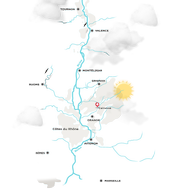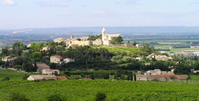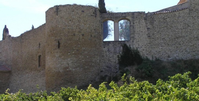|
|
 |

Three decades is not a long time when considered in relation to wine history--even modern wine history. During this relatively short span, wines from France’s Rhône Valley have risen from peasant status vinous royalty, with top bottlings from Châteauneuf-du-Pape, Côte-Rôtie and Hermitage often ringing up for more than $100 and sometimes more than  $500. Equally important, however, is the fact that quality at lower price levels is strikingly strong, with the region’s low crop yields translating into wines that are full of flavor and character but still easy to enjoy even when quite young. $500. Equally important, however, is the fact that quality at lower price levels is strikingly strong, with the region’s low crop yields translating into wines that are full of flavor and character but still easy to enjoy even when quite young.
The Rhône wines that are most reliable (though not necessarily the most expensive) come from “AOCs,” legally delimited areas that control the grape varieties, yield levels, and geographical locations required for usage of a particular place name (or appellation). The newest of these AOCs is Cairainne, which was granted this status in 2016, and which clearly deserves it based on recent releases. This sort of thing doesn’t happen all the time, and indeed, AOC status hasn’t been conferred on a village since Rasteau in 2010, and before that, you’d need to go back to 2005 when Beaumes de Venise and Vinsobres were added to the club.  Most wine lovers will need a little time to learn to look for "Cairanne" on labels, but those who are quick on the draw will get excellent wines that are still priced very reasonably. Most wine lovers will need a little time to learn to look for "Cairanne" on labels, but those who are quick on the draw will get excellent wines that are still priced very reasonably.
Cairanne is located in the southern portion of the Rhône, which produces roughly 10 times as much wine as the north. Grenache is the leading variety, and a minimum of 50% of any Cairanne wine must be comprised of this grape. Mourvedre and Syrah are also major players, weighing in at between 20% and 50% of Cairanne wines. Other varieties such as Counoise or Carignan may be used, but not at levels exceeding 30% of the final blend. White wines are also made under the new AOC designation, but they only make up about 3% of production, so we can safely overlook those for the moment. Rosé wines cannot carry the Cairanne name, so when you see the word, you should, basically, see red.
In terms of surface area, vines cover nearly 2,700 acres. Average yields are very low by global standards (35 hectoliters per hectare), and that’s explained largely by the presence of many old, head-pruned vines. As in  most of the southern Rhône, soils are mixed on account of the agency of the river, which deposited silt, rounded alluvial rocks, and gouged down into ancient subsoils. As most readers know, soil variation is a positive aspect for a wine region, especially when multiple grapes are planted, permitting the vines to be arrayed where each variety can maximize its potential. most of the southern Rhône, soils are mixed on account of the agency of the river, which deposited silt, rounded alluvial rocks, and gouged down into ancient subsoils. As most readers know, soil variation is a positive aspect for a wine region, especially when multiple grapes are planted, permitting the vines to be arrayed where each variety can maximize its potential.
Below you’ll find recommendations of wines made from vineyards in Cairanne that I tasted in the region in April. Most bottles won’t reflect Cairanne’s newly exalted status, on account of the fact that it was only  awarded in 2016. All of the 2016 vintage wines will simply be labeled, “Cairanne,” but most earlier wines are labeled, “Côte du Rhône Villages Cairanne,” which one rung down the classification ladder. Beneath that are wines labeled, “Côte du Rhône Villages,” which are blended from vineyards in multiple villages of note, whereas the lowest designation is simply “Côte du Rhône,” which can include any grapes grown anywhere within the broadest circumference of the whole designated region. awarded in 2016. All of the 2016 vintage wines will simply be labeled, “Cairanne,” but most earlier wines are labeled, “Côte du Rhône Villages Cairanne,” which one rung down the classification ladder. Beneath that are wines labeled, “Côte du Rhône Villages,” which are blended from vineyards in multiple villages of note, whereas the lowest designation is simply “Côte du Rhône,” which can include any grapes grown anywhere within the broadest circumference of the whole designated region.
A quick word on vintages: 2010 was a superb year, but you’d be very lucky to find any of these still on store shelves. Both 2011 and 2012 were good vintages, but I wouldn’t pass up more recent years to go back to these. 2013 produced a very small crop on account of spring frosts, but the wines are quite concentrated due to low yields, so they are definitely worth a try.
2014 produced a big crop (to the relief of growers), but by the time the wines started being sold, 2015 was already grabbing all the headlines (for reasons explained below). I was very impressed with many of the 2014s from the southern Rhône that I tasted in April, as the wines are more savory and less obviously ripe and fruity than the widely heralded 2015s. Don’t miss them just because the ‘15s and ‘16s are being hailed as the “Vintages of the Century” (which was also said of 2009 and 2010, just as a reality check).
Wines from 2015 are certainly striking, with ample size and very forward fruit. It was a warm and very dry growing season, so dry that the vines in many vineyards actually shut down in late summer. They were revived by rains that came at just the right time to enable them to resume ripening activity and plump up grapes that were on the way to raisining. Wines from the vintage are certainly worth trying, and some are worth more aggressive stocking, but my advice is not to get swept up in the hype over them. This is for two reasons: Some show excessive ripeness in the form of alcoholic heat in their “finishing” flavors, and 2016 promises to be an even better vintage, thanks to slower and more even ripening.
You’d already have picked up on the fact that I’m wary of “hype” regarding 2015, and given that “Inter Rhône,” the region’s promotional arm, is publishing characterizations of 2016 as “a perfect year” (their bold print), you might wonder…why am I not also skeptical about claims regarding 2016? The reason, quite simply, is that 2016 was being tagged as “perfect” while most 2015s had still not been released for sale.
The upshot for Rhône lovers whether you particularly admire wines from the south or the north is this: Buy some 2015s to try, but if you’re planning to take a hammer to your piggy bank to stock up big-time, it seems that 2016 will be better still.
Current releases from Cairanne appear below in order of preference:
Domaine des Amadieu “Hauts de Beauregard” 2014: You can call this “sauvage” in French or “wild” in English…but it will answer to either word, and loudly. Biodynamically farmed, it is very earthy, with a hint of brettanomyces, but the gamy note isn’t dominant, and the dense, deeply-flavored fruit is entirely capable of supporting this exotic accent note. Explosively aromatic, this is a borderline scary wine. Don’t serve it to your grandmother, and as for yourself, be seated for your first encounter with it. 94
Les Chemins de Sève “Apanage” 2014: This is a brand new domaine, and 2014 was the first vintage. Vines were planted last year, so this wine was made from fruit grown by neighbors. It is difficult to imagine how a new vintner (an industrial engineer until 2011 before beginning wine studies) could get a quicker or more impressive start. This is exceptionally pure, with very dense, dark toned fruit with intriguing savory undertones. Giant but still graceful, this is terrific. A star on the rise. 94
Domaine Alary “La Brunote” 2014: This exceedingly impressive wine seems to be sold predominantly in the Netherlands, and I’m actually tempted to make the trip for that reason, as it sells for less than $17 but tastes like $45. The color is very deep, with notes of both red and black fruits, though it is really more savory than fruity in general profile (though this earthiness never shades over into a dirty or “animal” character). Damn. 93
Domaine Boisson “L’Exigence” 2015: Very dark and ripe, this is a kick-down-the-door wine, rather than a reticent charmer. The fruit is very open and expressive, and if there were not a bit of alcoholic heat showing in the finish, it would have earned an even higher score. Some of this is being sold in the 2010 and 2012 vintages at various locations in the USA, so we can hope that the 2015 will also appear on our shores. 93
Cave de Cairanne / Camille Cayran “La Reserve” 2015: Judging from this wine, the individuals at this village co-op who are selecting fruit and working in the cellar are conspicuously talented for an establishment of this type. The fruit shows terrific purity and texture that is soft but not unfocused, with savory undertones accenting the flavors, which seem Grenache-dominant. Multiple retailers in France, Germany and Denmark are selling this for the Euro equivalent of less than $10, and you can buy it in Paris--in magnum--for less than $17. Vintners in California had better be glad that they’re insulated from competition at this level by both a continent and an ocean. 92
Domaine Juliette Avril “Cuvée Mailys” 2015: Evidence indicates that almost all of this wine is sold locally, but that’s really just one more reason to travel to the southern Rhône. A big wine with lots of depth and density but no alcoholic heat at all, it is very impressive, with lots of coiled power that promises positive development for at least 3 or 4 years. 92
Domaine Berthet-Rayne Castel Mireio Vieilli 2014: This special bottling (as opposed to the straight Vieilles Vignes or “old vines) shows a lot of ripeness but just the faintest hint of raisining. However, there is a powerful undertow of meaty, savory notes that keeps this from seeming over-ripe or obvious. There’s no telling how long it will last, and I doubt it will improve from additional ageing, but it is pretty damned exciting right now. 92
Domaine Brusset “Les Chabriles” Vieilles Vignes 2015: This isn’t as big a wine as this excellent producer’s Gigondas bottlings, but there’s no doubt that it is still very good, with more reddish fruit tones and a brighter character that will enable this to work well with many different foods. 92
Domaine de la Gayere “Villa Romana” 2015: Although quite rich, this is very sexy and soft in texture. Wines of this size with this textural character are almost always hot with alcohol--but there’s no hint of that in this case. I wouldn’t buy loads of this for fear that it might not improve or even last well, but for current consumption, it is worth a search. 92
Domaine les Hautes Cances “Cuvée Tradition” 2014: Not for no reason is the word “Tradition” attached to this wine, which is an exciting throwback bottling with a pronounced rusticity. Gutsy, leathery, savory, grippy and compelling, this offers a wild ride that won’t be to everyone’s taste, but it will damned sure get everyone’s attention. 92
Domaine Wilfried 2015: This is a moderately priced wine, but it doesn’t look like one, as the fruit is scarily dark in both pigmentation and flavor tone. Loaded with power but showing no alcoholic heat whatsoever, this is bloody impressive. 92
Domaine des Coteaux des Travers “Terra Rosea” 2015: A biodynamically-farmed wine that shows serious treatment in the cellar as well as the vineyard, with a firm tannic spine and years of potential improvement. Already quite impressive, but built to develop over time. 91+
Domaine de Dionysos “La Trilougio” 2014: This is obviously a “prestige” bottling of Cairainne, sold in a big bottle at a premium price. The wine is huge in proportions and flavor impact, and would earn a significantly higher price if not for notable alcoholic heat in the finish. No doubt plenty of other tasters will admire this more than I did, so if you are a fan of big, sappy southern Rhônes, give this a try. 91
Domaine La Vitalis 2015: Readers of a certain age will chortle at the name of this wine when recalling a horrible male hair tonic, but any derisive amusement will be dispelled immediately by the wine. Rich, deeply flavored fruit is framed by gutsy, grippy tannins--especially for a wine from 2015. Serious stuff, and very successful. 91
Domaine Berthet-Rayne Vieilles Vignes 2015: Juicy and ripe, but with some nice verve thanks to a fresh beam of acidity. Simple, but in a straightforward and delicious way. Drink now with spicy grilled meats. 90
|
 |
|